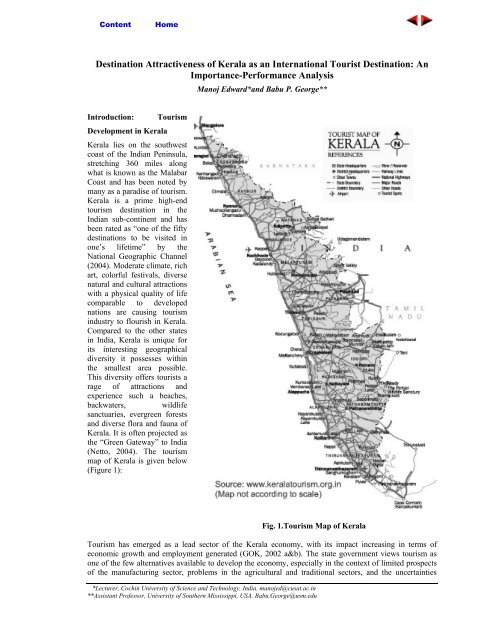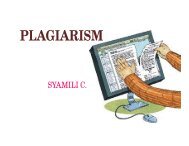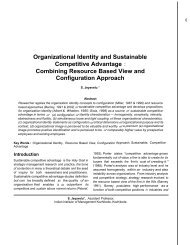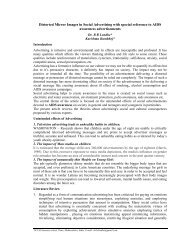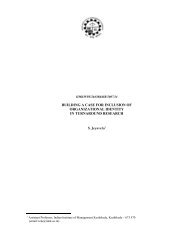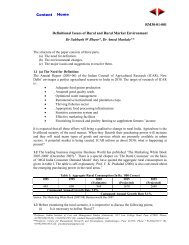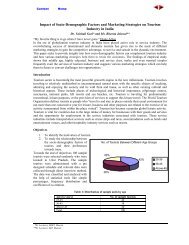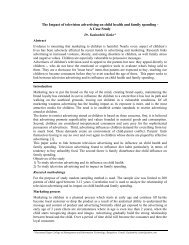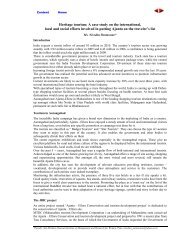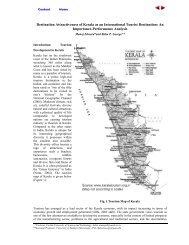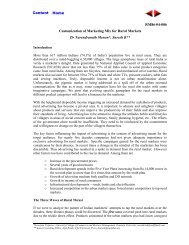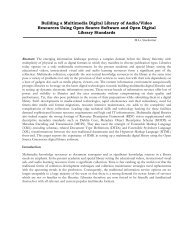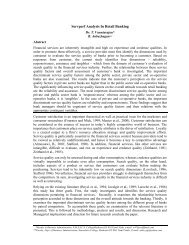Destination Attractiveness of Kerala as an International Tourist ...
Destination Attractiveness of Kerala as an International Tourist ...
Destination Attractiveness of Kerala as an International Tourist ...
You also want an ePaper? Increase the reach of your titles
YUMPU automatically turns print PDFs into web optimized ePapers that Google loves.
<strong>Destination</strong> <strong>Attractiveness</strong> <strong>of</strong> <strong>Kerala</strong> <strong>as</strong> <strong>an</strong> <strong>International</strong> <strong>Tourist</strong> <strong>Destination</strong>: An<br />
Import<strong>an</strong>ce-Perform<strong>an</strong>ce Analysis<br />
M<strong>an</strong>oj Edward*<strong>an</strong>d Babu P. George**<br />
Introduction: Tourism<br />
Development in <strong>Kerala</strong><br />
<strong>Kerala</strong> lies on the southwest<br />
co<strong>as</strong>t <strong>of</strong> the Indi<strong>an</strong> Peninsula,<br />
stretching 360 miles along<br />
what is known <strong>as</strong> the Malabar<br />
Co<strong>as</strong>t <strong>an</strong>d h<strong>as</strong> been noted by<br />
m<strong>an</strong>y <strong>as</strong> a paradise <strong>of</strong> tourism.<br />
<strong>Kerala</strong> is a prime high-end<br />
tourism destination in the<br />
Indi<strong>an</strong> sub-continent <strong>an</strong>d h<strong>as</strong><br />
been rated <strong>as</strong> “one <strong>of</strong> the fifty<br />
destinations to be visited in<br />
one’s lifetime” by the<br />
National Geographic Ch<strong>an</strong>nel<br />
(2004). Moderate climate, rich<br />
art, colorful festivals, diverse<br />
natural <strong>an</strong>d cultural attractions<br />
with a physical quality <strong>of</strong> life<br />
comparable to developed<br />
nations are causing tourism<br />
industry to flourish in <strong>Kerala</strong>.<br />
Compared to the other states<br />
in India, <strong>Kerala</strong> is unique for<br />
its interesting geographical<br />
diversity it possesses within<br />
the smallest area possible.<br />
This diversity <strong>of</strong>fers tourists a<br />
rage <strong>of</strong> attractions <strong>an</strong>d<br />
experience such a beaches,<br />
backwaters, wildlife<br />
s<strong>an</strong>ctuaries, evergreen forests<br />
<strong>an</strong>d diverse flora <strong>an</strong>d fauna <strong>of</strong><br />
<strong>Kerala</strong>. It is <strong>of</strong>ten projected <strong>as</strong><br />
the “Green Gateway” to India<br />
(Netto, 2004). The tourism<br />
map <strong>of</strong> <strong>Kerala</strong> is given below<br />
(Figure 1):<br />
Fig. 1.Tourism Map <strong>of</strong> <strong>Kerala</strong><br />
Tourism h<strong>as</strong> emerged <strong>as</strong> a lead sector <strong>of</strong> the <strong>Kerala</strong> economy, with its impact incre<strong>as</strong>ing in terms <strong>of</strong><br />
economic growth <strong>an</strong>d employment generated (GOK, 2002 a&b). The state government views tourism <strong>as</strong><br />
one <strong>of</strong> the few alternatives available to develop the economy, especially in the context <strong>of</strong> limited prospects<br />
<strong>of</strong> the m<strong>an</strong>ufacturing sector, problems in the agricultural <strong>an</strong>d traditional sectors, <strong>an</strong>d the uncertainties<br />
*Lecturer, Cochin University <strong>of</strong> Science <strong>an</strong>d Technology, India. m<strong>an</strong>ojed@cusat.ac.in<br />
**Assist<strong>an</strong>t Pr<strong>of</strong>essor, University <strong>of</strong> Southern Mississippi, USA. Babu.George@usm.edu
IIMK Part IV – Service Quality & Satisfaction IIML<br />
facing the expatriate employment in the Persi<strong>an</strong> Gulf (Pushp<strong>an</strong>gad<strong>an</strong>, 2003). <strong>Kerala</strong> is now considered <strong>as</strong> a<br />
tourism model for other states in India to emulate its growth. Tourism industry in <strong>Kerala</strong> witnessed<br />
considerable growth during nineties <strong>an</strong>d beyond <strong>an</strong>d is expected to grow further in the future. <strong>Kerala</strong> is one<br />
<strong>of</strong> the earliest Indi<strong>an</strong> states to <strong>an</strong>nounce industry status for tourism in 1986 <strong>an</strong>d <strong>an</strong>nounce various incentives<br />
<strong>an</strong>d subsidies to attract investment (Rao <strong>an</strong>d Suresh, 2001).<br />
<strong>Kerala</strong>’s share <strong>of</strong> international tourists coming to India h<strong>as</strong> incre<strong>as</strong>ed from 5.54 percent in 1994 to 8.85%<br />
percent in 2005 making it a leading state for tourism in the country. Earnings from tourism is also projected<br />
to grow at a record level <strong>of</strong> more th<strong>an</strong> 23.5 percent which is very high th<strong>an</strong> earnings growth projected for<br />
India <strong>an</strong>d world average which is 14.3 percent <strong>an</strong>d 6.5 percent. During this same period, tourism receipts<br />
from international tourists also grew considerably, from 116 crore in 1994 to 1988.40 crore in 2006 (GOK,<br />
2006). <strong>International</strong> tourist arrivals to <strong>Kerala</strong> had reached almost half million in 2006, <strong>an</strong>d is expected to<br />
cross 5 lakh by 2007. For the domestic tourism, the arrivals had crossed 60 lakhs in 2006. This almost<br />
meets the prediction <strong>of</strong> world Travel <strong>an</strong>d Tourism Council (WTTC) that with <strong>an</strong> average <strong>an</strong>nual arrival<br />
growth rate <strong>of</strong> 18% for domestic tourists <strong>an</strong>d 12% for international tourists <strong>Kerala</strong> is becoming one <strong>of</strong> the<br />
f<strong>as</strong>test growing destinations in the world (WTTC, 2002). The growth <strong>of</strong> domestic <strong>an</strong>d international tourism<br />
in <strong>Kerala</strong> <strong>an</strong>d its relative position in the Indi<strong>an</strong> tourism in the recent p<strong>as</strong>t is depicted in tables 1.1 <strong>an</strong>d 1.2.<br />
Table 1.1. <strong>International</strong> & Domestic <strong>Tourist</strong>s Arrivals (Source: Department <strong>of</strong> Tourism,<br />
Government <strong>of</strong> <strong>Kerala</strong>, <strong>Tourist</strong> Statistics, 1994, 1998, 2002, 2006)<br />
Year <strong>International</strong> tourists Domestic tourists<br />
1994 104568 1284375<br />
1996 176855 4403002<br />
1998 189941 4481714<br />
2000 209893 5013221<br />
2002 232564 5568256<br />
2004 345546 5972182<br />
2006 428534 6271724<br />
Table 1.2. <strong>Kerala</strong>’s share <strong>of</strong> foreign tourists to India (Source: Department <strong>of</strong> Tourism, Government<br />
<strong>of</strong> <strong>Kerala</strong>, <strong>Tourist</strong> Statistics, 1994, 1998, 2002, 2004)<br />
Year India <strong>Kerala</strong> % Share<br />
1994 1886433 104568 5.54<br />
1996 2287860 176855 7.73<br />
1998 2358629 189941 7.68<br />
2000 2649378 209893 7.92<br />
2002 2384364 232564 9.75<br />
2004 3367980 345546 10.26<br />
Tourism is also counted <strong>as</strong> <strong>an</strong> import<strong>an</strong>t alternative to address unemployment which is a major problem<br />
facing the state (Kokkr<strong>an</strong>ikal <strong>an</strong>d Morrison, 2002). Further re<strong>as</strong>ons making tourism industry attractive for<br />
the state includes, its strong linkages with other sectors in the state, <strong>an</strong>d its potential for generating benefits<br />
more widespread throughout the state for a given level <strong>of</strong> capital investment compared to other sectors. A<br />
study done shows a strong multiplier effect for tourism industry in the state for both output multiplier <strong>an</strong>d<br />
employment multiplier (TCS, 2000). With regard to employment generation in the state, Travel <strong>an</strong>d tourism<br />
industry is expected to create 7.5 lakh jobs in the next 10 years <strong>an</strong>d the broader impact <strong>of</strong> it on economy<br />
c<strong>an</strong> create 1.4 million jobs during this period (WTTC, 2002).<br />
Underst<strong>an</strong>ding tourists’ preferences <strong>an</strong>d their perception <strong>of</strong> the destination are considered essential inputs in<br />
tourism pl<strong>an</strong>ning <strong>an</strong>d marketing efforts (Kotler et al., 2005). With this idea in mind, the present study<br />
employs the Import<strong>an</strong>ce-Perform<strong>an</strong>ce technique to evaluate the destination attractiveness <strong>of</strong> <strong>Kerala</strong>, <strong>as</strong><br />
perceived by the international tourists’ visiting <strong>Kerala</strong>. The implications <strong>of</strong> the study are discussed in detail.<br />
In addition, this paper attempts to provide a broad overview <strong>of</strong> the salient features <strong>of</strong> tourism practice in the<br />
state <strong>of</strong> <strong>Kerala</strong>.<br />
Conference on Tourism in India – Challenges Ahead, 15-17 May 2008, IIMK 166
IIMK Part IV – Service Quality & Satisfaction IIML<br />
The State’s Tourism Policy Framework<br />
As noted elsewhere, <strong>Kerala</strong> is one <strong>of</strong> the earliest states in India to <strong>an</strong>nounce industry status for tourism in<br />
1986 <strong>an</strong>d <strong>an</strong>nounce various incentives <strong>an</strong>d subsidies to attract investment. These early efforts were aimed<br />
at creating the investment friendly atmosphere for tourism in the state needed for the industry to grow. This<br />
incre<strong>as</strong>ed the investment opportunities for potential investors. Main lending institutions like KFC (<strong>Kerala</strong><br />
Fin<strong>an</strong>cial Corporation), TFCI (Travel Fin<strong>an</strong>cial Corporation <strong>of</strong> India) <strong>an</strong>d KSIDC (<strong>Kerala</strong> state industrial<br />
development corporation) played import<strong>an</strong>t role in funding the tourism projects. State also adopted m<strong>an</strong>y<br />
proactive me<strong>as</strong>ures to stimulate investment in tourism industry like a system for f<strong>as</strong>t track clear<strong>an</strong>ce <strong>of</strong><br />
tourism projects, subsidies, technical guid<strong>an</strong>ce, marketing <strong>as</strong>sist<strong>an</strong>ce <strong>an</strong>d support in availing lo<strong>an</strong>s (GOI,<br />
1998).<br />
The shift in emph<strong>as</strong>is <strong>of</strong> tourism department to a more proactive role <strong>of</strong> tourism development <strong>an</strong>d<br />
marketing <strong>an</strong>d promotion <strong>of</strong> the destination started since early nineties (Kokkr<strong>an</strong>ikal <strong>an</strong>d Baum, 2002). The<br />
first tourism policy that came out in 1995 spells out the major direction for growth in the industry. Priority<br />
are<strong>as</strong> identified were infr<strong>as</strong>tructure development, hum<strong>an</strong> resource development for tourism, marketing <strong>an</strong>d<br />
product development (GOK, 1995). Thereafter this tourism policy remained the b<strong>as</strong>is for much <strong>of</strong> the states<br />
progress over the l<strong>as</strong>t 10 years whether in terms <strong>of</strong> infr<strong>as</strong>tructure, product development or tourism<br />
perform<strong>an</strong>ce (WTTC, 2002). The key role played by private sector in all these are<strong>as</strong> w<strong>as</strong> identified in<br />
addition to defining the role <strong>of</strong> state <strong>as</strong> a facilitator creating the suitable condition for investment by<br />
creating the b<strong>as</strong>ic infr<strong>as</strong>tructure for tourism to grow.<br />
For the first time the m<strong>an</strong>ner <strong>of</strong> growth needed w<strong>as</strong> also envisioned in the first tourism policy, i.e.<br />
promoting destination more <strong>as</strong> quality destination, attracting high spending tourists th<strong>an</strong> going for m<strong>as</strong>s<br />
tourism ch<strong>as</strong>ing numbers (GOK, 1995). This conscious strategy <strong>of</strong> taking the destination <strong>Kerala</strong> away from<br />
m<strong>as</strong>s tourism to a destination with a boutique image attracting tourists <strong>of</strong> a specific t<strong>as</strong>te required<br />
developing new tourism products <strong>an</strong>d new destination regions. Diversifying to new products w<strong>as</strong> also a part<br />
<strong>of</strong> strategy <strong>of</strong> differentiation especially when other nearby states <strong>an</strong>d nearby regions like Sril<strong>an</strong>ka <strong>an</strong>d<br />
Maldives <strong>of</strong>fer same kind <strong>of</strong> products <strong>of</strong> superior value. So in addition to beaches, <strong>Kerala</strong> <strong>as</strong> a destination<br />
started developing <strong>an</strong>d promoting varied tourist products like backwater with house boat attractions <strong>an</strong>d<br />
Ayurveda rejuvenation holidays attractions. The first tourism policy also highlighted the need for creating<br />
hum<strong>an</strong> resources <strong>of</strong> good quality to serve the growing needs <strong>of</strong> the industry to promote quality tourism<br />
(GOK, 1995).<br />
The stated objective <strong>of</strong> the state government is to promote <strong>Kerala</strong> more <strong>as</strong> quality destination, attracting<br />
high spending tourists th<strong>an</strong> going for m<strong>as</strong>s tourism ch<strong>as</strong>ing numbers (GOK, 1995). This conscious strategy<br />
<strong>of</strong> taking the destination <strong>Kerala</strong> away from m<strong>as</strong>s tourism to a destination with a boutique image attracting<br />
tourists <strong>of</strong> a specific t<strong>as</strong>te required developing new tourism products <strong>an</strong>d new destination regions. Varied<br />
tourism products like backwater attractions <strong>an</strong>d ayurvedic rejuvenation b<strong>as</strong>ed attractions have helped to<br />
acquire a unique image in the international <strong>an</strong>d domestic markets.<br />
Despite setting the direction for growth in the tourism industry, the initial tourism policy framework <strong>of</strong> the<br />
state w<strong>as</strong> not sound <strong>an</strong>d it lacked in providing a detailed action pl<strong>an</strong> for the destination to grow. The<br />
government came out with a new policy document titled “Vision 2020” in the year 2000 which w<strong>as</strong> more<br />
comprehensive <strong>an</strong>d stressed the sustainability concerns along with the tourism growth (<strong>Kerala</strong> Tourism,<br />
2007). Among others, it reflected on the growing concern for environmental conservation, heritage <strong>an</strong>d<br />
culture protection, lack <strong>of</strong> b<strong>as</strong>ic infr<strong>as</strong>tructure surrounding major destinations, <strong>an</strong>d the need for proper<br />
quality <strong>as</strong>sur<strong>an</strong>ce systems <strong>an</strong>d legislations to regulate <strong>an</strong>d bring quality in tourism. It also stressed on the<br />
integrated development <strong>of</strong> infr<strong>as</strong>tructure with special tourism zones b<strong>as</strong>ed on m<strong>as</strong>ter pl<strong>an</strong>s so that the<br />
pristine quality <strong>of</strong> the environment is preserved for making <strong>Kerala</strong> <strong>an</strong> up market high quality destination.<br />
The new policy aims to make tourism <strong>Kerala</strong>’s core competency sector <strong>an</strong>d gives special emph<strong>as</strong>is on<br />
enh<strong>an</strong>cing the employment potential <strong>of</strong> the sector for alleviating poverty thereby making tourism the most<br />
import<strong>an</strong>t sector for the socio-economic development <strong>an</strong>d environment protection <strong>of</strong> the state. Apart from<br />
reiterating the role <strong>of</strong> the Government <strong>as</strong> a facilitator for the growth <strong>of</strong> tourism industry, it h<strong>as</strong> also<br />
identified the need for the state to come up with regulations for directing the growth <strong>of</strong> tourism in the right<br />
direction (Netto, 2004).<br />
Product Development <strong>an</strong>d <strong>Destination</strong> Marketing<br />
From the first tourism policy onwards there w<strong>as</strong> <strong>an</strong> emph<strong>as</strong>is on developing new product or new<br />
destination every year. This is part <strong>of</strong> tourism strategy to develop <strong>an</strong> image <strong>of</strong> up market high quality<br />
Conference on Tourism in India – Challenges Ahead, 15-17 May 2008, IIMK 167
IIMK Part IV – Service Quality & Satisfaction IIML<br />
destination for <strong>Kerala</strong> to attract high spending discerning travelers who seek unique experiences from the<br />
destination. Incre<strong>as</strong>ing the appeal for ayurvedic rejuvenation holidays <strong>an</strong>d heritage attractions in the<br />
international <strong>an</strong>d domestic markets <strong>an</strong>d exp<strong>an</strong>ding variety in accommodation provision <strong>of</strong> boutique resorts<br />
<strong>an</strong>d heritage hotels etc are some <strong>of</strong> the l<strong>an</strong>dmarks in successful product development efforts in the tourism<br />
industry. It is this <strong>as</strong>pect <strong>of</strong> the destination, National Geographic reported regarding the resort architecture<br />
<strong>as</strong> one <strong>of</strong> the best in the country blending culture <strong>an</strong>d ethos <strong>of</strong> the l<strong>an</strong>d. Initiatives taken by government for<br />
converting old buildings <strong>of</strong> traditional <strong>Kerala</strong> architecture (traditional nalukettus <strong>an</strong>d tharavadus) to<br />
heritage type accommodation properties will add further to this image.<br />
Enh<strong>an</strong>cing the appeal <strong>of</strong> tourist attractions with suitable product innovation came up in m<strong>an</strong>y forms. For<br />
inst<strong>an</strong>ce, Traditional ketuvallams (country boats) converted into improved <strong>an</strong>d uniquely designed house<br />
boats with modern facilities <strong>of</strong>fer tourist a unique experience <strong>of</strong> backwater attractions. Innovations were<br />
also seen in developing unique tourism packages with niche attractions: Thekady Tiger Trail developed in<br />
collaboration with forest department involving 25-30 km <strong>of</strong> trek through the wild life s<strong>an</strong>ctuary; <strong>an</strong>d ‘a day<br />
with m<strong>as</strong>ters’ a tourism package developed enabling tourists to experience intensely traditional art forms<br />
like Kathakali, Kodiyattom <strong>an</strong>d Theyyam, spending time with great m<strong>as</strong>ters in these art forms (<strong>Kerala</strong><br />
Tourism, 2007).<br />
Initiatives for creating variety <strong>of</strong> tourism products <strong>of</strong>fer tourists <strong>an</strong> enriching experience <strong>of</strong> <strong>Kerala</strong>. Such<br />
initiatives c<strong>an</strong> be either enh<strong>an</strong>cing the existing tourist attractions or developing new attractions. Tourism<br />
packages developed around pl<strong>an</strong>tations sector, ‘avi<strong>an</strong>’ tourism to attract bird watchers; <strong>an</strong>d developing<br />
tourism packages to promote <strong>Kerala</strong> <strong>as</strong> a Meetings Incentives, Conventions <strong>an</strong>d Exhibitions (MICE)<br />
destination are few such initiatives. Another emerging tourism form is eco tourism, linking tourism<br />
development <strong>an</strong>d environment. This project h<strong>as</strong> come up in Thenmala, in the Western Ghats, where<br />
activities such <strong>as</strong> trekking through rain forest <strong>an</strong>d staying in tree top huts are org<strong>an</strong>ized. It is probably the<br />
first pl<strong>an</strong>ned eco tourism destination in the country, implemented with the support <strong>of</strong> forest department <strong>an</strong>d<br />
the local community (<strong>Kerala</strong> Tourism, 2007).<br />
One area the state performed well is promotion <strong>an</strong>d marketing <strong>of</strong> the destination. This is achieved through<br />
focused marketing efforts during the l<strong>as</strong>t 10 years. There were also efforts at br<strong>an</strong>ding the destination along<br />
with the focused promotional strategies around the theme ‘gods own country’. In a way this h<strong>as</strong> resulted in<br />
creating a boutique image for the destination in the various generating markets. These efforts helped to<br />
differentiate the destination from the other states <strong>of</strong> India. In this process, <strong>Kerala</strong> <strong>as</strong> a tourist destination h<strong>as</strong><br />
evolved into a br<strong>an</strong>d <strong>of</strong> its own. <strong>Kerala</strong> is listed among the top 100 br<strong>an</strong>ds <strong>of</strong> the country, by the globally<br />
renowned super br<strong>an</strong>ds ltd. This br<strong>an</strong>d equity held by the destination c<strong>an</strong> be effectively exploited in the<br />
years to come <strong>an</strong>d c<strong>an</strong> give the destination a head start over other states <strong>of</strong> India (Netto, 2004).<br />
Over the years the state h<strong>as</strong> adopted consistently a strategic approach to marketing <strong>of</strong> destination given the<br />
limited marketing budget <strong>an</strong>d consequently created the desired impact in building the awareness <strong>an</strong>d appeal<br />
for the destination both in the domestic <strong>an</strong>d international markets. During this period, <strong>Kerala</strong> took the bold<br />
initiative <strong>of</strong> participating with its own pavilion in key international travel fairs in Europe <strong>an</strong>d west Asia,<br />
which are the key markets for the destination. Attending independently such import<strong>an</strong>t travel fairs enabled<br />
marketing the destination directly to the key intermediaries such <strong>as</strong> international tour operators, airlines <strong>an</strong>d<br />
travel media for incre<strong>as</strong>ed visibility in the clutter <strong>of</strong> global tourism map (WTTC, 2002).<br />
Another high impact marketing initiative w<strong>as</strong> the launch <strong>of</strong> <strong>Kerala</strong> Travel mart (KTM) in 2000 which is<br />
now India’s premier international travel mart which gets overwhelming response from the trade. KTM<br />
2002 saw the participation <strong>of</strong> trade from new markets like USA, Denmark, Greece, Irel<strong>an</strong>d <strong>an</strong>d Sweden.<br />
With these efforts, destination <strong>Kerala</strong> h<strong>as</strong> started getting noticed in the global tourisms map even <strong>as</strong> a st<strong>an</strong>d<br />
alone destination. This is also reflected in rele<strong>as</strong>e <strong>of</strong> <strong>Kerala</strong> exclusive guide book from widely referred<br />
travel guide called lonely pl<strong>an</strong>et. Wide acclaim from reputed travel magazines like National geographic,<br />
Condi N<strong>as</strong>t traveler <strong>an</strong>d high pr<strong>of</strong>ile endorsement <strong>of</strong> destination by celebrities helped greatly to create a<br />
favorable image for destination in m<strong>an</strong>y <strong>of</strong> the generating markets.<br />
Promotional initiatives also relied on media like web <strong>an</strong>d direct marketing route. A highly interactive<br />
website, road shows in selected international <strong>an</strong>d domestic markets, high quality brochures <strong>an</strong>d CDs <strong>as</strong><br />
promo materials were some <strong>of</strong> the additional promotional initiatives which reflect the strategic approach to<br />
marketing the state undertook. These promotional efforts combined with the participation in the<br />
international travel fairs in key markets created a synergistic effect in attracting both the international <strong>an</strong>d<br />
domestic tourists to the state (TCS, 2000).<br />
Private sector participation in all platforms – whether in policy making, promotion <strong>an</strong>d product<br />
development w<strong>as</strong> a distinctive feature <strong>of</strong> tourism development pursued in <strong>Kerala</strong> (WTTC, 2002). In fact<br />
Conference on Tourism in India – Challenges Ahead, 15-17 May 2008, IIMK 168
IIMK Part IV – Service Quality & Satisfaction IIML<br />
KTM, the mega marketing event <strong>of</strong> the state for tourism, is the initiative <strong>of</strong> the private sector, conducted in<br />
partnership with the government, demonstrates the active involvement <strong>of</strong> private sector in the tourism<br />
pl<strong>an</strong>ning <strong>an</strong>d development activities. Clearly, the m<strong>an</strong>y levels <strong>of</strong> cooperation <strong>an</strong>d partnerships developed<br />
between the government <strong>an</strong>d various other stakeholders formed the b<strong>as</strong>is for m<strong>an</strong>y tourism development<br />
efforts: public- private sector joint venture for infr<strong>as</strong>tructure development; joint marketing efforts with<br />
other southern states; committees for coordination between departments, enabling investment climate <strong>an</strong>d<br />
tourism related facilities <strong>an</strong>d services improvement; <strong>an</strong>d district tourism promotion councils for<br />
decentralization <strong>of</strong> tourism development (<strong>Kerala</strong> Tourism, 2007).<br />
Quality <strong>as</strong>sur<strong>an</strong>ce <strong>an</strong>d control efforts were also targeted at these major tourism products like house boats<br />
<strong>an</strong>d ayurvedic rejuvenation centers <strong>an</strong>d hotels. This include gold star <strong>an</strong>d silver star certification for<br />
houseboats b<strong>as</strong>ed on materials used for their construction, facilities <strong>of</strong>fered by them, the quality <strong>of</strong><br />
furniture, services, <strong>an</strong>d the safety <strong>an</strong>d security me<strong>as</strong>ures. For promoting eco friendly me<strong>as</strong>ures among<br />
houseboats, green palm certification is launched. For ensuring the quality, safety <strong>an</strong>d service st<strong>an</strong>dards <strong>of</strong><br />
the ayurvedic centers, Green Leaf’ <strong>an</strong>d ‘Olive Leaf’ Certifications are given b<strong>as</strong>ed on the evaluation <strong>of</strong> the<br />
authenticity <strong>of</strong> the treatment provided, the training <strong>of</strong> the staff, the conveniences <strong>an</strong>d amenities, <strong>an</strong>d the<br />
quality <strong>of</strong> furniture (TCS, 2000).<br />
Another certification scheme launched is to certify hotels <strong>as</strong> STEP’ (Safe-To-Eat Places) Certification<br />
b<strong>as</strong>ed on their hygiene <strong>an</strong>d quality st<strong>an</strong>dards in the preparation <strong>an</strong>d serving <strong>of</strong> cuisine. In addition to the<br />
improvement quality <strong>of</strong> the core attractions, the government h<strong>as</strong> taken initiatives to improve the facilitation<br />
services which include exp<strong>an</strong>ding the network <strong>of</strong> tourism information centers <strong>an</strong>d convenience facilities<br />
such <strong>as</strong> toilets, communication <strong>an</strong>d related services at all import<strong>an</strong>t locations (<strong>Kerala</strong> Tourism, 2007).<br />
The Import<strong>an</strong>ce-Perform<strong>an</strong>ce Technique<br />
Systematic approaches to quality me<strong>as</strong>urement with e<strong>as</strong>y to use <strong>an</strong>d reliable me<strong>as</strong>ures are import<strong>an</strong>t for<br />
service firms, especially when there are only fewer objective me<strong>as</strong>ures <strong>of</strong> quality by which to judge their<br />
production (Hudson <strong>an</strong>d Sheppard, 1998). In turn, this will help m<strong>an</strong>agers to know better what <strong>as</strong>pects <strong>of</strong> a<br />
service best define its quality <strong>an</strong>d c<strong>an</strong> prepare the org<strong>an</strong>ization to take up a competitive position b<strong>as</strong>ed upon<br />
its ability to deliver what customers dem<strong>an</strong>d (Cronin <strong>an</strong>d Taylor, 1992).<br />
In response to the growing import<strong>an</strong>ce <strong>of</strong> service quality <strong>as</strong> a me<strong>an</strong>s <strong>of</strong> gaining competitive adv<strong>an</strong>tage,<br />
researchers have developed more detailed attribution techniques aimed at me<strong>as</strong>uring customer perceived<br />
service quality within the services sector (e.g. Par<strong>as</strong>uram<strong>an</strong>, Zeithaml <strong>an</strong>d Berry 1985; Cronin <strong>an</strong>d Taylor,<br />
1992). The majority <strong>of</strong> these studies have adopted the expect<strong>an</strong>cy - disconfirmation paradigm, which<br />
defines quality <strong>as</strong> a disconfirmation <strong>of</strong> expectation to perform<strong>an</strong>ce. The most popular use <strong>of</strong> the<br />
disconfirmation approach is <strong>of</strong> Par<strong>as</strong>uram<strong>an</strong>, Zeithaml <strong>an</strong>d Berry (1985) <strong>an</strong>d the development <strong>of</strong> their<br />
SERVQUAL instrument. Despite its popularity, SERVQUAL instrument h<strong>as</strong> limitations due to its generic<br />
dimensions, which are found not consistent across industries. Furthermore, the practical difficulty <strong>of</strong><br />
<strong>as</strong>sessing expectations <strong>an</strong>d perform<strong>an</strong>ce separately, <strong>an</strong>d the complexities regarding the nature <strong>of</strong> how<br />
expectations are formed (Brown, Churchill <strong>an</strong>d Peter 1993; Zeithaml, Berry <strong>an</strong>d Par<strong>as</strong>uram<strong>an</strong>, 1993) limits<br />
its usage. The need to simplify <strong>an</strong>d improve the reliability <strong>of</strong> the me<strong>as</strong>urement <strong>of</strong> service quality h<strong>as</strong> lead<br />
researchers to develop more direct approach using perform<strong>an</strong>ce-only b<strong>as</strong>ed me<strong>as</strong>ures <strong>of</strong> service quality.<br />
Principal amongst these h<strong>as</strong> been the work <strong>of</strong> Cronin <strong>an</strong>d Taylor (1992) <strong>an</strong>d the development <strong>of</strong> the<br />
SERVPERF technique.<br />
Another direct me<strong>as</strong>urement technique is the Import<strong>an</strong>ce-Perform<strong>an</strong>ce <strong>an</strong>alysis (IPA) technique which<br />
emerged from the earlier work <strong>of</strong> Martilla <strong>an</strong>d James (1977). Unlike SERVPERF, the Import<strong>an</strong>ce-<br />
Perform<strong>an</strong>ce technique allows simult<strong>an</strong>eous comparison <strong>of</strong> direct perform<strong>an</strong>ce me<strong>as</strong>ure <strong>of</strong> service quality<br />
to the import<strong>an</strong>ce rating given by customers for the various quality items being evaluated. The inclusion <strong>of</strong><br />
customer preference rating in IPA gives a better picture <strong>of</strong> customers’ quality <strong>as</strong>sessment <strong>of</strong> product or<br />
service. According to Barsky (1995) such relative <strong>as</strong>sessments pinpoint clearly the quality <strong>as</strong>pects <strong>of</strong><br />
product or service which contributes greatly to customer satisfaction. As a result the information derived<br />
out <strong>of</strong> import<strong>an</strong>ce-perform<strong>an</strong>ce <strong>an</strong>alysis (IPA) c<strong>an</strong> aid the development <strong>of</strong> more focused marketing<br />
strategies ((Ford et al., 1999). This view is confirmed by Lovelock, Patterson <strong>an</strong>d Walker (1999) who state<br />
that import<strong>an</strong>ce-perform<strong>an</strong>ce <strong>an</strong>alysis is a useful m<strong>an</strong>agement tool which c<strong>an</strong> help firms to redirect their<br />
scarce resources from low impact are<strong>as</strong> to high impact are<strong>as</strong>. This technique is also called Key Driver<br />
Analysis.<br />
Conference on Tourism in India – Challenges Ahead, 15-17 May 2008, IIMK 169
IIMK Part IV – Service Quality & Satisfaction IIML<br />
In IPA, customers perception <strong>an</strong>d import<strong>an</strong>ce values are plotted on a grid that is divided into 4 quadr<strong>an</strong>ts,<br />
formed b<strong>as</strong>ed on the me<strong>an</strong> scores <strong>of</strong> the import<strong>an</strong>ce perception ratings. The values are then <strong>as</strong>sessed<br />
according to its position in the quadr<strong>an</strong>t on the grid. Each quadr<strong>an</strong>t suggests different response from a<br />
marketing strategy point <strong>of</strong> view. Attributes that are rated high in import<strong>an</strong>ce <strong>an</strong>d high in perform<strong>an</strong>ce /<br />
perception score suggest that service providers keep up the ‘good’ work <strong>an</strong>d incre<strong>as</strong>e resources directed<br />
towards these are<strong>as</strong>. In contr<strong>as</strong>t, attributes having low import<strong>an</strong>ce rating <strong>an</strong>d a low perform<strong>an</strong>ce rating<br />
suggest that investing resources to these are<strong>as</strong> may <strong>of</strong>fer only little adv<strong>an</strong>tage. Attributes that are rated high<br />
in import<strong>an</strong>ce <strong>an</strong>d low in perform<strong>an</strong>ce are are<strong>as</strong> that the providers should pay particular attention for<br />
improvement. L<strong>as</strong>tly, attributes rated low in import<strong>an</strong>ce <strong>an</strong>d high in perform<strong>an</strong>ce are are<strong>as</strong> providers should<br />
continue to maintain the level <strong>of</strong> effort. The beauty <strong>of</strong> IPA is that it c<strong>an</strong> help a business underst<strong>an</strong>d what its<br />
customers feel is import<strong>an</strong>t to it across a number <strong>of</strong> relev<strong>an</strong>t variables.<br />
As noted elsewhere, this paper reports the application <strong>of</strong> the Import<strong>an</strong>ce-Perform<strong>an</strong>ce me<strong>as</strong>urement<br />
technique within the tourism sector for <strong>an</strong> integrated tourism product like destination, <strong>an</strong>d tries to develop<br />
implications for destination marketing. Researchers have used IPA framework for service quality research<br />
in travel <strong>an</strong>d tourism (Ev<strong>an</strong>s <strong>an</strong>d Chon, 1989; Go <strong>an</strong>d Zh<strong>an</strong>g, 1997, O’Neill et al., 2002). Most <strong>of</strong> these<br />
studies <strong>as</strong>sessed service quality <strong>as</strong>sessment for specific tourism products. As <strong>an</strong> extension <strong>of</strong> its use, this<br />
study attempts to use IPA for evaluating international tourists’ perceived destination attractiveness for<br />
<strong>Kerala</strong>. In this regard, destination attractiveness is represented in terms <strong>of</strong> various tourist attractions <strong>an</strong>d<br />
experience elements identified in the qualitative ph<strong>as</strong>e <strong>of</strong> the study, for its inherent appeal to attract tourists<br />
to the destination in the first place. M<strong>an</strong>y destination elements like safety, access, tr<strong>an</strong>sportation,<br />
information provisions were not included in this study, owing to the fact that these elements rarely attracts<br />
tourists to a particular destination, even though they c<strong>an</strong> influence the tourists’ holiday satisfaction to <strong>an</strong><br />
extent.<br />
Research Method<br />
The research followed a two-stage methodology, comprising qualitative <strong>an</strong>d qu<strong>an</strong>titative stage. The<br />
qualitative stage involved <strong>an</strong>alyses <strong>of</strong> various brochures, interviews with experts from the tourism industry<br />
<strong>an</strong>d free response survey with tourists <strong>as</strong> part <strong>of</strong> knowing the various relev<strong>an</strong>t destination attraction <strong>an</strong>d<br />
experience elements relev<strong>an</strong>t to <strong>Kerala</strong> holiday experience. This information is used for the subsequent<br />
qu<strong>an</strong>titative study carried out using a survey method with a structured questionnaire to get the data from the<br />
international tourists visiting <strong>Kerala</strong>. Around 400 responses were obtained for <strong>an</strong>alysis. Respondents<br />
selected were the international tourists departing the state through the two international airports in the State:<br />
Cochin <strong>an</strong>d Triv<strong>an</strong>drum. The Control over the sample w<strong>as</strong> exercised by limiting the number <strong>of</strong> tourists<br />
surveyed in a day <strong>an</strong>d by selecting respondents at different time <strong>of</strong> the day.<br />
Ideally for a study <strong>of</strong> this type, destination attribute import<strong>an</strong>ce needs to be me<strong>as</strong>ured prior to, rather th<strong>an</strong><br />
after, <strong>an</strong> actual purch<strong>as</strong>e experience. But due to the practical difficulty in meeting tourists prior to the visit,<br />
import<strong>an</strong>ce ratings are taken at post consumption stage. Perform<strong>an</strong>ce is then me<strong>as</strong>ured using the same set <strong>of</strong><br />
attributes so that import<strong>an</strong>ce <strong>an</strong>d perform<strong>an</strong>ce <strong>of</strong> the destination c<strong>an</strong> be directly compared for each<br />
attraction via the IPA plot (or grid). The me<strong>an</strong> values <strong>of</strong> import<strong>an</strong>ce <strong>an</strong>d perform<strong>an</strong>ce scores are then used<br />
<strong>as</strong> the crossing point in constructing the IPA grid.<br />
Horizontal axis in the IPA grid indicates the tourists’ perception <strong>of</strong> the destination attraction <strong>an</strong>d provisions<br />
me<strong>as</strong>ured in a 5 point impression rating scale. The vertical axis indicates the import<strong>an</strong>ce for the same<br />
destination attraction <strong>an</strong>d provision elements me<strong>as</strong>ured in 5 point import<strong>an</strong>ce rating scale. <strong>Tourist</strong>s’<br />
perception rating <strong>an</strong>d the import<strong>an</strong>ce rating for the fifteen destination attributes <strong>an</strong>d activities used <strong>as</strong> input<br />
for the IPA is presented in Table 2.<br />
The fifteen attributes are taken <strong>as</strong> a b<strong>as</strong>is for destination attractiveness evaluation. Apart from using general<br />
attractions like climate, local culture representing overall destination appeal, tourists’ impression with<br />
specific attractions like backwaters, hill stations, <strong>an</strong>d auyrvedic rejuvenation experience <strong>of</strong>fered at the<br />
destination are included for <strong>as</strong>sessing the destination attractiveness. As the <strong>as</strong>sessment <strong>of</strong> destination<br />
attractiveness is from the tourist perspective, only tourism specific attractions <strong>an</strong>d activities are included in<br />
the IPA.<br />
The study included both controllable <strong>an</strong>d uncontrollable destination attributes. This is in contr<strong>as</strong>t to m<strong>an</strong>y<br />
service strategy formulation studies, using IPA, where the general practice is to include only controllable<br />
variables. In such c<strong>as</strong>es, IPA is used <strong>as</strong> a prescriptive tool for directing or redirecting resources to different<br />
service quality are<strong>as</strong>. In this study, the focus being on <strong>as</strong>sessing destination attractiveness quality <strong>of</strong> a<br />
Conference on Tourism in India – Challenges Ahead, 15-17 May 2008, IIMK 170
IIMK Part IV – Service Quality & Satisfaction IIML<br />
destination, both controllable <strong>an</strong>d uncontrollable factors are used. For example, attributes like local culture<br />
<strong>an</strong>d m<strong>an</strong>y natural attractions like wildlife <strong>an</strong>d hill stations are difficult to improve beyond a level for they<br />
are resources given for developing tourism. Such attributes are included in this study because here IPA is<br />
used <strong>as</strong> a descriptive tool to underst<strong>an</strong>d the destination attractiveness. As a descriptive tool, here IPA is<br />
used both for indicating the need for improvements in some key destination are<strong>as</strong>, <strong>as</strong> well <strong>as</strong> to reveal the<br />
less controllable destination attraction elements on which destination promotion <strong>an</strong>d positioning activities<br />
c<strong>an</strong> be b<strong>as</strong>ed. Moreover, <strong>an</strong>other re<strong>as</strong>on for such a choice is that most <strong>of</strong> the attributes used in this study are<br />
<strong>as</strong>sessed at <strong>an</strong> aggregate level.<br />
Table 2. Import<strong>an</strong>ce-Perform<strong>an</strong>ce Me<strong>an</strong>s<br />
The average level <strong>of</strong> rating with various attractions <strong>of</strong> <strong>Kerala</strong> <strong>an</strong>d the average import<strong>an</strong>ce <strong>of</strong> the attractions<br />
for tourists were calculated for the whole sample. As part <strong>of</strong> <strong>as</strong>sessing destination attractiveness matrix,<br />
these me<strong>an</strong> scores were plotted in <strong>an</strong> Import<strong>an</strong>ce –Perform<strong>an</strong>ce rating matrix <strong>as</strong> shown in figure 2. The<br />
gr<strong>an</strong>d me<strong>an</strong>s for impression rating (x= 2.95) <strong>an</strong>d import<strong>an</strong>ce (y = 3.5) determines the placements <strong>of</strong> axes on<br />
the grid. Each attraction is then <strong>as</strong>sessed by locating in the appropriate quadr<strong>an</strong>t. <strong>Tourist</strong>s’ perception <strong>an</strong>d<br />
import<strong>an</strong>ce values are plotted on the grid that is divided into 4 quadr<strong>an</strong>ts that are formed b<strong>as</strong>ed on the me<strong>an</strong><br />
scores <strong>of</strong> the import<strong>an</strong>ce perception ratings. These values are then <strong>as</strong>sessed according to the quadr<strong>an</strong>t on the<br />
grid it is placed. Each quadr<strong>an</strong>t suggests a different response from the destination marketing strategy point<br />
<strong>of</strong> view.<br />
Conference on Tourism in India – Challenges Ahead, 15-17 May 2008, IIMK 171
IIMK Part IV – Service Quality & Satisfaction IIML<br />
Fig. 2. Import<strong>an</strong>ce-Perform<strong>an</strong>ce Matrix<br />
<strong>Destination</strong> Attractions <strong>an</strong>d provisions that are rated high in import<strong>an</strong>ce <strong>an</strong>d perception scores are are<strong>as</strong> <strong>of</strong><br />
strength for the destination appeal <strong>an</strong>d consequently the destination marketing activities c<strong>an</strong> be more<br />
focused on these elements. Are<strong>as</strong> having low import<strong>an</strong>ce rating <strong>an</strong>d a low perception rating indicate<br />
destination attractions which c<strong>an</strong> be regarded <strong>as</strong> peripheral to the core destination appeal, <strong>an</strong>d therefore<br />
require less <strong>of</strong> destination development <strong>an</strong>d marketing efforts. Attractions <strong>an</strong>d provisions that are rated high<br />
in import<strong>an</strong>ce <strong>an</strong>d low in perception are are<strong>as</strong> that destination marketers should pay particular attention for<br />
development <strong>an</strong>d repositioning in the destination marketing activities. L<strong>as</strong>tly, are<strong>as</strong> rated low in import<strong>an</strong>ce<br />
<strong>an</strong>d high in perceptions are attractions where destination marketing c<strong>an</strong> continue to maintain the same level<br />
<strong>of</strong> effort because <strong>of</strong> the less scope for enh<strong>an</strong>cement in the level <strong>of</strong> tourists’ satisfaction through these are<strong>as</strong>.<br />
Analysis <strong>an</strong>d Discussion<br />
Plotting destination attractions <strong>an</strong>d experience elements in <strong>an</strong> Import<strong>an</strong>ce – Perform<strong>an</strong>ce matrix reveals that<br />
climate, backwaters, local cuisine, rest <strong>an</strong>d relax environments, <strong>an</strong>d local culture falls in the quadr<strong>an</strong>t 1<br />
(high import<strong>an</strong>t <strong>an</strong>d high impression). As destination attractiveness elements, these attributes c<strong>an</strong> be viewed<br />
<strong>as</strong> the strength <strong>of</strong> the destination appeal for the international tourist market in <strong>Kerala</strong>, <strong>an</strong>d suggest key are<strong>as</strong><br />
on which destination marketing activities c<strong>an</strong> be further developed. What is interesting is the representation<br />
<strong>of</strong> local cuisine <strong>as</strong> <strong>an</strong> import<strong>an</strong>t dimension <strong>of</strong> destination quality <strong>as</strong>sessment, <strong>an</strong>d furthermore, its<br />
signific<strong>an</strong>ce suggests that this attraction c<strong>an</strong> be further highlighted in the destination promotion activities.<br />
Similarly, the presence <strong>of</strong> backwaters, local culture, rest <strong>an</strong>d relax environments in this quadr<strong>an</strong>t projects<br />
certain unique characteristics determining core appeal <strong>of</strong> the destination, which c<strong>an</strong> be further packaged<br />
effectively in the destination positioning exercises.<br />
<strong>Destination</strong> attraction elements falling in quadr<strong>an</strong>t 2 (high import<strong>an</strong>t <strong>an</strong>d low impression) are beaches, art /<br />
craft forms <strong>an</strong>d heritage attractions , <strong>an</strong>d therefore these are destination attraction are<strong>as</strong> where destination<br />
development <strong>an</strong>d marketing efforts need more attention to turn them into are<strong>as</strong> <strong>of</strong> perceived strengths for<br />
the destination. Comparing the relative positions <strong>of</strong> the attractions in this quadr<strong>an</strong>t, reveal that beach<br />
attractions being placed higher in the quadr<strong>an</strong>t <strong>of</strong>fers more potential in improving the destination<br />
attractiveness for <strong>Kerala</strong>. Therefore, beach attractions, one <strong>of</strong> the import<strong>an</strong>t attractions for the destination,<br />
Conference on Tourism in India – Challenges Ahead, 15-17 May 2008, IIMK 172
IIMK Part IV – Service Quality & Satisfaction IIML<br />
needs more attention in development <strong>an</strong>d marketing for enh<strong>an</strong>cing the quality <strong>of</strong> beaches <strong>an</strong>d its appeal.<br />
Though somewhat less in signific<strong>an</strong>ce, other attractions like art forms <strong>an</strong>d heritage sites, identified by their<br />
position in IPA matrix, too needs further improvement in their development <strong>an</strong>d therefore should form <strong>an</strong><br />
import<strong>an</strong>t part <strong>of</strong> destination development activities for <strong>Kerala</strong> to attract international tourists.<br />
<strong>Destination</strong> attractions <strong>an</strong>d elements which fall in the quadr<strong>an</strong>t three are wildlife attractions,<br />
accommodation st<strong>an</strong>dards, shopping, nightlife <strong>an</strong>d adventure & fun activities (low import<strong>an</strong>ce <strong>an</strong>d low<br />
impression). At <strong>an</strong> aggregate level <strong>of</strong> <strong>as</strong>sessment, these destination quality elements appear less signific<strong>an</strong>t<br />
for enh<strong>an</strong>cing the destination appeal for international tourists compared to other attractions in quadr<strong>an</strong>t 1<br />
<strong>an</strong>d quadr<strong>an</strong>t 2. This finding, especially with regard to accommodation, appears contradictory to some <strong>of</strong><br />
the insights obtained during the initial qualitative stage <strong>of</strong> study using interviews with tourists <strong>an</strong>d<br />
m<strong>an</strong>agers where the import<strong>an</strong>ce accommodation w<strong>as</strong> repeatedly highlighted by the respondents. It is also<br />
possible that true nature <strong>of</strong> import<strong>an</strong>ce <strong>of</strong> some <strong>of</strong> these attributes may be m<strong>as</strong>ked in this IPA <strong>an</strong>alysis. In<br />
fact, some <strong>of</strong> these attractions <strong>an</strong>d provisions, especially accommodations, c<strong>an</strong> be more <strong>of</strong> dissatisfier th<strong>an</strong><br />
<strong>as</strong> a satisfier, that is, a drop in the perform<strong>an</strong>ce level <strong>of</strong> these provisions may signific<strong>an</strong>tly alter the tourists’<br />
satisfaction levels. The lower position <strong>of</strong> nightlife <strong>an</strong>d adventure/fun activities in this quadr<strong>an</strong>t clearly<br />
indicates that these are<strong>as</strong> are les import<strong>an</strong>t <strong>as</strong> far <strong>as</strong> <strong>Kerala</strong> is concerned <strong>an</strong>d therefore needs less effort <strong>as</strong><br />
part <strong>of</strong> destination development activities, compared to other are<strong>as</strong> <strong>of</strong> attractions. However, using proper<br />
segmentation studies, the potential to attract particular segments <strong>of</strong> tourists with high preference for these<br />
attractions needs to be further explored.<br />
L<strong>as</strong>tly, <strong>Destination</strong> attractions spotted in the quadr<strong>an</strong>t 4 (low import<strong>an</strong>ce, high impression) are ayurvedic<br />
rejuvenation attraction <strong>an</strong>d hill stations. The indication is that at <strong>an</strong> aggregate level <strong>of</strong> <strong>as</strong>sessment <strong>as</strong><br />
destination attraction elements, they are perceived better th<strong>an</strong> what is expected. Nevertheless, the<br />
possibility <strong>of</strong> unique segments <strong>of</strong> tourists who seek high levels <strong>of</strong> quality from ayurvedic rejuvenation<br />
experience <strong>an</strong>d hill station attractions may necessitate the import<strong>an</strong>ce <strong>of</strong> taking initiatives to improve<br />
quality in these attractions.<br />
Conclusion<br />
During the l<strong>as</strong>t decade, tourism in <strong>Kerala</strong> h<strong>as</strong> made a spectacular perform<strong>an</strong>ce. From 1999 onwards,<br />
consecutively for three years, <strong>Kerala</strong> Tourism h<strong>as</strong> got the Best Performing Indi<strong>an</strong> State award. Some <strong>of</strong> the<br />
main tourism development initiatives taken by <strong>Kerala</strong> which enabled it to become one <strong>of</strong> the leading<br />
destinations internationally are:<br />
• Focused marketing efforts within a limited budget, developed in active partnership with private sector,<br />
leading international travel firms <strong>an</strong>d agencies.<br />
• Early lead in formulating comprehensive tourism policy, guiding <strong>an</strong>d setting long term vision <strong>an</strong>d<br />
goals for the tourism sector growth.<br />
• Successful differentiation <strong>of</strong> the destination using effective positioning strategy, <strong>an</strong>d benchmarking the<br />
perform<strong>an</strong>ce with the neighboring leading international destinations, in the process, developed a<br />
distinct image <strong>as</strong> a st<strong>an</strong>d alone destination from India <strong>an</strong>d the rest <strong>of</strong> the states.<br />
• Development <strong>of</strong> <strong>an</strong> array <strong>of</strong> tourism products <strong>of</strong> world cl<strong>as</strong>s appeal mostly b<strong>as</strong>ed on resources<br />
available locally.<br />
Added to these, the socio-economic context <strong>of</strong> <strong>Kerala</strong> defined by the high level <strong>of</strong> social development <strong>an</strong>d<br />
the contr<strong>as</strong>ting industrial backwardness turned out to be a perfect setting for promoting <strong>Kerala</strong> <strong>as</strong> <strong>an</strong><br />
unspoiled destination with exotic characteristics. In most parts <strong>of</strong> <strong>Kerala</strong>, the movement from <strong>an</strong> agrari<strong>an</strong><br />
society to the present day information society w<strong>as</strong> byp<strong>as</strong>sing the intermediate stage <strong>of</strong> the industrial society<br />
(Govind<strong>an</strong>, 1996).<br />
With the simult<strong>an</strong>eous consideration <strong>of</strong> tourists’ <strong>as</strong>sessment <strong>of</strong> the import<strong>an</strong>ce <strong>of</strong> salient attributes for the<br />
destination experience <strong>an</strong>d their level <strong>of</strong> impression with the destination attributes, we have used the IPA to<br />
<strong>as</strong>sociate tourists’ destination quality perception <strong>an</strong>d their requirements. Being focused on <strong>an</strong> overall<br />
<strong>as</strong>sessment <strong>of</strong> the total destination experience, destination attractions <strong>an</strong>d provisions are me<strong>as</strong>ured at <strong>an</strong><br />
aggregate level. Nevertheless, <strong>as</strong> a starting point, this is sufficient to provide the essential insights on<br />
destination attractiveness <strong>as</strong> perceived by the tourists. The <strong>an</strong>alysis h<strong>as</strong> revealed the strengths <strong>an</strong>d weakness<br />
<strong>of</strong> the destination from a dem<strong>an</strong>d side perspective. We discovered that most <strong>of</strong> the attraction elements that<br />
are considered <strong>as</strong> import<strong>an</strong>t by the international tourists visiting the state have <strong>an</strong> above average<br />
Conference on Tourism in India – Challenges Ahead, 15-17 May 2008, IIMK 173
IIMK Part IV – Service Quality & Satisfaction IIML<br />
perform<strong>an</strong>ce rating, too. In the light <strong>of</strong> the above discussion, this is not something str<strong>an</strong>ge. In fact, the<br />
competitive adv<strong>an</strong>tage <strong>of</strong> <strong>Kerala</strong> is inimitable to a very great extent: for example, climate, culture,<br />
backwaters, etc are rated to be import<strong>an</strong>t attraction elements; they are also superior in perform<strong>an</strong>ce. There<br />
are a few items in the fourth quadr<strong>an</strong>t, which essential me<strong>an</strong>s that the state should not be committing much<br />
<strong>of</strong> its limited promotional budget upon promoting them. Instead, more attention may be focused up on<br />
promoting the beaches <strong>an</strong>d the state’s heritage: these are greatly expected, but low in perform<strong>an</strong>ce. <strong>Kerala</strong><br />
is a co<strong>as</strong>tal state <strong>an</strong>d beaches are one <strong>of</strong> its biggest <strong>as</strong>sets. One re<strong>as</strong>on why beaches do not perform up to<br />
expectations could be that the state government downplays beach tourism. <strong>Kerala</strong> w<strong>an</strong>ts to be a high end<br />
tourism destination <strong>an</strong>d its government is worried that promotion <strong>of</strong> the beachside will push the state into a<br />
low end m<strong>as</strong>s tourist haven. This could be a wrongly placed notion since previous research says that beach<br />
tourists visiting <strong>Kerala</strong> are high spenders; probably they spend more th<strong>an</strong> those who visit in search <strong>of</strong><br />
heritage <strong>an</strong>d culture (Raj<strong>as</strong>en<strong>an</strong> <strong>an</strong>d Kumar, 2002). Or, it may be that only high spending beach tourists<br />
visit <strong>Kerala</strong> due to the government’s beach de-marketing efforts.<br />
These are valuable inputs for destination promotion <strong>an</strong>d positioning activities. The <strong>an</strong>alysis indicated the<br />
import<strong>an</strong>ce <strong>of</strong> certain destination attraction elements like climate, backwaters, cuisine, <strong>an</strong>d rest <strong>an</strong>d<br />
relaxation environments, <strong>an</strong>d local culture <strong>as</strong> strengths <strong>of</strong> the destination b<strong>as</strong>ed on which destination<br />
promotional activities c<strong>an</strong> be further reinforced. Are<strong>as</strong> where destination attractiveness gaps observed<br />
includes, beaches, art forms, <strong>an</strong>d heritage attractions, <strong>an</strong>d points to need for further emph<strong>as</strong>is on area<br />
specific development efforts to enh<strong>an</strong>ce the tourists experience with these attractions. With <strong>an</strong> array <strong>of</strong><br />
attractions <strong>an</strong>d experience elements provided at the destination, it may be useful to view the destination <strong>as</strong> a<br />
composite product, with certain attractions forming the core <strong>an</strong>d the others at the peripheral, augmenting<br />
the tourists’ experience <strong>of</strong> core attractions. In this conceptualization, attractions like nightlife, shopping <strong>an</strong>d<br />
adventure activities may belong to a peripheral category; these attractions also need improvement efforts,<br />
but to a less extent, <strong>as</strong> compared to some <strong>of</strong> the core attractions. Overall, findings indicate the need for<br />
different strategies for guiding both the product <strong>an</strong>d promotional development activities targeted for<br />
different tourism products.<br />
It may be recalled that the destination quality attributes generated through the qualitative ph<strong>as</strong>e <strong>of</strong> the study<br />
included both controllable <strong>an</strong>d non-controllable items. This is because, in addition to the purpose <strong>of</strong><br />
correcting <strong>an</strong>d diagnosing problems for the core destination m<strong>an</strong>agement activities, the use <strong>of</strong> noncontrollable<br />
items (culture, environment, climate etc) included in this study provided better quality<br />
<strong>as</strong>sessment <strong>of</strong> the destination b<strong>as</strong>ed on tourists’ perspective, considered <strong>as</strong> a useful input for destination<br />
marketing programmes.<br />
We do not argue that a democratic state like <strong>Kerala</strong> should devise its tourism strategy purely b<strong>as</strong>ed on the<br />
whims <strong>an</strong>d f<strong>an</strong>cies <strong>of</strong> the tourists (Sreekumar <strong>an</strong>d Govind<strong>an</strong>, 2002). There c<strong>an</strong> be import<strong>an</strong>t priorities for<br />
the state: for inst<strong>an</strong>ce, Ayurveda (<strong>an</strong> alternative medical treatment) is in the fourth quadr<strong>an</strong>t: marketing<br />
research may dictate that it be neglected. But, it gives employment to a lot <strong>of</strong> people <strong>an</strong>d is <strong>an</strong> import<strong>an</strong>t<br />
reflection <strong>of</strong> the state’s culture. In such c<strong>as</strong>es, international market segments that do not currently patronize<br />
the state but which consider these types <strong>of</strong> products <strong>as</strong> import<strong>an</strong>t should be identified <strong>an</strong>d cajoled with<br />
suitable promotional schemes. This is true in general: <strong>an</strong> import<strong>an</strong>ce-perform<strong>an</strong>ce <strong>an</strong>alysis is merely the<br />
perceptions <strong>of</strong> the currently patronizing segment. It does not me<strong>an</strong> that some attractions considered<br />
unworthy by these segments will never be sold or that these attractions need not be preserved. There could<br />
be a market segment waiting somewhere for every type <strong>of</strong> product: real success lies in identifying it (Levitt,<br />
2004).<br />
Some noteworthy limitations <strong>of</strong> the study c<strong>an</strong> not go unmentioned: <strong>as</strong> this study is done for whole <strong>of</strong> the<br />
destination, detail evaluation <strong>of</strong> specific quality dimensions <strong>of</strong> each attraction w<strong>as</strong> not evaluated. Further, <strong>as</strong><br />
the data from the sample w<strong>as</strong> aggregated, the data may only represent <strong>an</strong> overall view <strong>of</strong> destination<br />
attractiveness <strong>as</strong> perceived by the international tourists. <strong>International</strong> tourist market to <strong>Kerala</strong> c<strong>an</strong> be<br />
segmented on various relev<strong>an</strong>t segmentation variables, <strong>an</strong>d destination attractiveness <strong>as</strong>sessment for<br />
specific tourist segments may reveal more information regarding destination attractiveness for <strong>Kerala</strong>.<br />
Therefore, future research should focus on these are<strong>as</strong>. Future research c<strong>an</strong> also be under taken, exclusively<br />
focusing on various destination quality elements such <strong>as</strong> safety, hygiene, access, tourist information etc to<br />
identify destination service quality gaps.<br />
It may be noted that this study is done purely for international tourists visiting <strong>Kerala</strong>. Given the volatile<br />
international tourism environment, no sensible destination m<strong>an</strong>agement authority c<strong>an</strong> neglect the<br />
import<strong>an</strong>ce-perform<strong>an</strong>ce ratings for the state’s attractions given by the domestic tourists. Thus, final<br />
tourism policy outcomes should be informed by the collective viewpoint emerging from the IPAs <strong>of</strong><br />
Conference on Tourism in India – Challenges Ahead, 15-17 May 2008, IIMK 174
IIMK Part IV – Service Quality & Satisfaction IIML<br />
domestic <strong>an</strong>d international tourist segments. As the next step, destination attractiveness <strong>as</strong>sessment should<br />
be also done for domestic tourists visiting <strong>Kerala</strong> <strong>as</strong> well. Most import<strong>an</strong>tly, this helps in identifying are<strong>as</strong><br />
<strong>of</strong> overlap: these are are<strong>as</strong> where you c<strong>an</strong> gain more customers with less spending.<br />
References<br />
Barsky, J.D. (1995). World-Cl<strong>as</strong>s Customer Satisfaction. Chicago, USA: Irwin Publishing.<br />
Bolton, R. <strong>an</strong>d Drew, J.H. (1991). A multistage model <strong>of</strong> customers' <strong>as</strong>sessments <strong>of</strong> service quality <strong>an</strong>d value. Journal<br />
<strong>of</strong> Consumer Research, 17(4), 375-84.<br />
Brown, T.J., Churchill, G.A. <strong>an</strong>d Peter, J.P. (1993). Improving the me<strong>as</strong>urement <strong>of</strong> service quality. Journal <strong>of</strong> Retailing,<br />
69, 127-139.<br />
Cronin, J.J. <strong>an</strong>d Taylor, S. A. (1992). Me<strong>as</strong>uring service quality: A re-examination <strong>an</strong>d extension. Journal <strong>of</strong><br />
Marketing, 56, 55-68.<br />
Elliot, J (1997). Tourism, Politics <strong>an</strong>d Public Sector M<strong>an</strong>agement. London <strong>an</strong>d New York: Routledge<br />
Ev<strong>an</strong>s, M. R. <strong>an</strong>d Chon, K. (1989). Formulating <strong>an</strong>d evaluating tourism policy using import<strong>an</strong>ce–perform<strong>an</strong>ce <strong>an</strong>alysis.<br />
Hospitality Education <strong>an</strong>d Research Journal, 13(3), 203–213.<br />
Ford, J.B., Joseph, M. <strong>an</strong>d Joseph, B. (1999). Import<strong>an</strong>ce-perform<strong>an</strong>ce <strong>an</strong>alysis <strong>as</strong> a strategic tool for service marketers:<br />
the c<strong>as</strong>e <strong>of</strong> service quality perceptions <strong>of</strong> business students in New Zeal<strong>an</strong>d <strong>an</strong>d the USA, The Journal <strong>of</strong><br />
Services Marketing, 13(2), 171-186.<br />
Go, F., <strong>an</strong>d Zh<strong>an</strong>g, W. (1997). Applying import<strong>an</strong>ce–perform<strong>an</strong>ce <strong>an</strong>alysis to Beijing <strong>as</strong> <strong>an</strong> international meeting<br />
destination. Journal <strong>of</strong> Travel Research, Spring, 42–49.<br />
GOI (Government <strong>of</strong> India, 1998). Report <strong>of</strong> the Seminar on Investment Opportunities in Tourism Sector in <strong>Kerala</strong>.<br />
Government <strong>of</strong> India <strong>Tourist</strong> Office, Kochi, 15-17.<br />
GOK (Government <strong>of</strong> <strong>Kerala</strong> Government <strong>of</strong> <strong>Kerala</strong>, 2006a). Economic Review. State Pl<strong>an</strong>ning Board, <strong>Kerala</strong>.<br />
GOK (Government <strong>of</strong> <strong>Kerala</strong>, 1995). Tourism Policy <strong>of</strong> <strong>Kerala</strong>. Department <strong>of</strong> Tourism, Govt <strong>of</strong> <strong>Kerala</strong>.<br />
GOK (Government <strong>of</strong> <strong>Kerala</strong>, 2000). Tourism Policy: Vision 2020. Department <strong>of</strong> Tourism, Govt <strong>of</strong> <strong>Kerala</strong>.<br />
GOK (Government <strong>of</strong> <strong>Kerala</strong>, 2002). <strong>Tourist</strong> Statistics <strong>of</strong> <strong>Kerala</strong>. Department <strong>of</strong> Tourism, Govt <strong>of</strong> <strong>Kerala</strong>.<br />
GOK (Government <strong>of</strong> <strong>Kerala</strong>, 2006). <strong>Tourist</strong> Statistics <strong>of</strong> <strong>Kerala</strong>. Department <strong>of</strong> Tourism, Govt <strong>of</strong> <strong>Kerala</strong>.<br />
Govind<strong>an</strong>, P. (1996). The '<strong>Kerala</strong> model' <strong>of</strong> development: Development <strong>an</strong>d sustainability in the Third World. Third<br />
World Quarterly, 17(5), 941-958.<br />
Hall, C.M (2000). Tourism Pl<strong>an</strong>ning: Policies, Processes <strong>an</strong>d Relationships. Harlow: Prentice Hall.<br />
Hudson, S. <strong>an</strong>d Shepherd, G.W.H. (1998). Me<strong>as</strong>uring service quality at tourist destinations: An application <strong>of</strong><br />
import<strong>an</strong>ce-perform<strong>an</strong>ce <strong>an</strong>alysis to <strong>an</strong> alpine ski resort. Journal <strong>of</strong> Travel <strong>an</strong>d Tourism Marketing, 7(3), 61-<br />
77.<br />
<strong>Kerala</strong> Tourism (2007). The Official Website <strong>of</strong> Tourism Ministry, Government <strong>of</strong> <strong>Kerala</strong>. Lat accessed on 1<br />
November 2007 from www.keralatourism.org<br />
Kokkr<strong>an</strong>ikal, J. <strong>an</strong>d Baum, T. (2002). Hum<strong>an</strong> resources development for tourism in rural communities: A c<strong>as</strong>e study <strong>of</strong><br />
<strong>Kerala</strong>. Asia Pacific Journal <strong>of</strong> Tourism Research, 7(2), 64-76.<br />
Kokkr<strong>an</strong>ikal, J. <strong>an</strong>d Morrison, A. (2002). Entrepreneurship <strong>an</strong>d sustainable tourism: A c<strong>as</strong>e study <strong>of</strong> the houseboats <strong>of</strong><br />
<strong>Kerala</strong>. Tourism <strong>an</strong>d Hospitality Research, 4 (1), 7-20.<br />
Kotler, P., Bowen, J., <strong>an</strong>d Makens, J. (2005). Marketing for Hospitality <strong>an</strong>d Tourism. NY: Pearson Education.<br />
Levitt, T. (2004). Marketing myopia. Harvard Business Review, 82 (7/8), 138-150.<br />
Lovelock, C., Patterson, P.G., <strong>an</strong>d Walker, R. H. (1998). Services Marketing. Sydney: Prentice Hall.<br />
Martilla, J. <strong>an</strong>d James, J. (1977). Import<strong>an</strong>ce-perform<strong>an</strong>ce <strong>an</strong>alysis. Journal <strong>of</strong> Marketing, 41 (J<strong>an</strong>uary), 77-79.<br />
National Geographic (2004). http://www.nationalgeographic.com/traveler/index50.html. L<strong>as</strong>t accessed on 19th July<br />
2006.<br />
Netto, N. (2004). Tourism development in <strong>Kerala</strong>. In Prak<strong>as</strong>h, B.A. (Ed.) <strong>Kerala</strong>'s Economic Development:<br />
Perform<strong>an</strong>ce <strong>an</strong>d Problems. New Delhi: Sage.<br />
O’Neill, M.A., Palmer, A., <strong>an</strong>d Charters, S. (2002). Wine production <strong>as</strong> service experience: Effects <strong>of</strong> service quality<br />
on wine sales. Journal <strong>of</strong> Services Marketing, 16 (4), 342-360.<br />
Par<strong>as</strong>uram<strong>an</strong>, A., Zeithaml, V. A., <strong>an</strong>d Berry, L. L (1985). A conceptual model <strong>of</strong> service quality <strong>an</strong>d its implications<br />
for future research. Journal <strong>of</strong> Marketing, 49 (Fall), 41-50.<br />
Pushp<strong>an</strong>gad<strong>an</strong>, K. (2003). Remitt<strong>an</strong>ces, Consumption <strong>an</strong>d Economic Growth in <strong>Kerala</strong>. Working Paper 343. <strong>Kerala</strong>,<br />
India: Centre for Development Studies.<br />
Raj<strong>as</strong>en<strong>an</strong>, D. <strong>an</strong>d Kumar, M.K.A. (2002). Demographic, psychographic <strong>an</strong>d life-style characteristics <strong>of</strong> foreign<br />
tourists: <strong>an</strong> exploratory study <strong>of</strong> <strong>Kerala</strong>, India. Tourism Recreation Research, 29(3) 51-59.<br />
Rao, N. <strong>an</strong>d Suresh, K.T. (2001). Domestic tourism in India. In Ghimire, K.B. (Ed.).<br />
Sreekumar, T.T. <strong>an</strong>d Govind<strong>an</strong>, P. (2002). Contentions <strong>an</strong>d contradictions <strong>of</strong> tourism <strong>as</strong> development option: The c<strong>as</strong>e<br />
<strong>of</strong> <strong>Kerala</strong>, India. Third World Quarterly, 23(3), 529-548.<br />
TCS (Tata Consult<strong>an</strong>cy Services, 2000). Economic Benefits <strong>of</strong> Tourism Sector in <strong>Kerala</strong>. Report <strong>of</strong> the study<br />
conducted by TATA Consult<strong>an</strong>cy Services, India.<br />
Conference on Tourism in India – Challenges Ahead, 15-17 May 2008, IIMK 175
IIMK Part IV – Service Quality & Satisfaction IIML<br />
The Native <strong>Tourist</strong>. London: Earthsc<strong>an</strong> Publications Limited, 198-228.<br />
Witt, C. <strong>an</strong>d Muhlem<strong>an</strong>n, A. (1995). Service quality in airlines. Tourism Economics, 1(1), 33-49.<br />
WTO (World Travel Org<strong>an</strong>ization 1998). Tourism 2020 Vision Executive Summary. Madrid: WTO Publications<br />
Division<br />
WTTC (World Travel <strong>an</strong>d Tourism Council, 2002). The Travel <strong>an</strong>d Tourism Satellite Account for <strong>Kerala</strong>: Impact <strong>of</strong><br />
Travel <strong>an</strong>d Tourism on the Jobs <strong>an</strong>d the Economy. New Delhi: WTTC.<br />
WTTC (World Travel <strong>an</strong>d Tourism Council, 2003). Executive Summary <strong>of</strong> the 2003 Travel <strong>an</strong>d Tourism Economic<br />
Research. London: WTTC.<br />
Zeithaml V. A., Berry, L. L., <strong>an</strong>d Par<strong>as</strong>uram<strong>an</strong>, A. (1993). The nature <strong>an</strong>d determin<strong>an</strong>ts <strong>of</strong> customer expectations <strong>of</strong><br />
service. Journal <strong>of</strong> the Academy <strong>of</strong> Marketing Science, 21 (1), 1-12.<br />
Conference on Tourism in India – Challenges Ahead, 15-17 May 2008, IIMK 176


